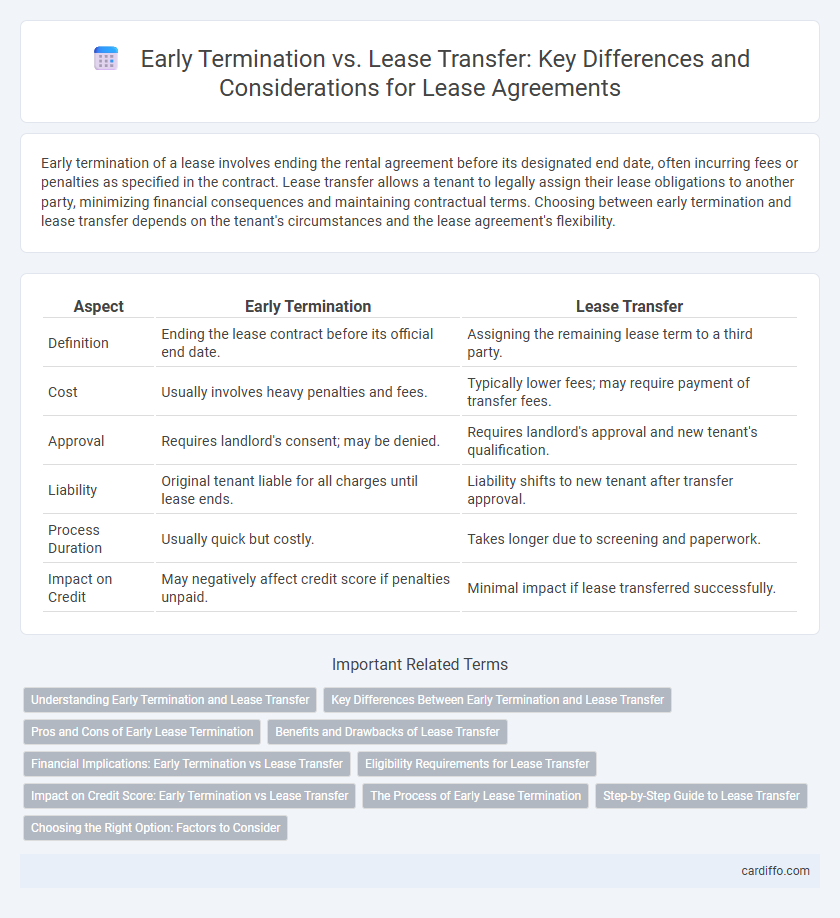Early termination of a lease involves ending the rental agreement before its designated end date, often incurring fees or penalties as specified in the contract. Lease transfer allows a tenant to legally assign their lease obligations to another party, minimizing financial consequences and maintaining contractual terms. Choosing between early termination and lease transfer depends on the tenant's circumstances and the lease agreement's flexibility.
Table of Comparison
| Aspect | Early Termination | Lease Transfer |
|---|---|---|
| Definition | Ending the lease contract before its official end date. | Assigning the remaining lease term to a third party. |
| Cost | Usually involves heavy penalties and fees. | Typically lower fees; may require payment of transfer fees. |
| Approval | Requires landlord's consent; may be denied. | Requires landlord's approval and new tenant's qualification. |
| Liability | Original tenant liable for all charges until lease ends. | Liability shifts to new tenant after transfer approval. |
| Process Duration | Usually quick but costly. | Takes longer due to screening and paperwork. |
| Impact on Credit | May negatively affect credit score if penalties unpaid. | Minimal impact if lease transferred successfully. |
Understanding Early Termination and Lease Transfer
Early termination allows a tenant to end a lease agreement before its scheduled expiration, often incurring fees or penalties as specified in the lease contract. Lease transfer, or lease assignment, involves transferring the remaining lease term and obligations to a new tenant, typically requiring landlord approval. Understanding the financial implications, responsibilities, and legal requirements is crucial for both early termination and lease transfer decisions.
Key Differences Between Early Termination and Lease Transfer
Early termination involves ending a lease agreement before its expiration, often incurring penalties or fees stipulated in the contract. Lease transfer, also known as lease assignment, allows the original lessee to transfer their lease obligations to a third party without breaking the contract. Key differences include financial responsibility, with early termination typically requiring payment of remaining rent or fees, whereas lease transfers shift obligations to the new lessee, often subject to landlord approval.
Pros and Cons of Early Lease Termination
Early lease termination offers tenants flexibility to exit a lease agreement before its natural end date but often involves significant penalties such as forfeited deposits or early termination fees. This option can provide a clean break without the need to find a replacement tenant, saving time but at a potentially high financial cost. However, early termination may negatively impact credit scores and rental history, making future leasing more challenging.
Benefits and Drawbacks of Lease Transfer
Lease transfer allows tenants to assign their lease obligations to a new party, offering flexibility to exit a lease early without penalty. Benefits include avoiding early termination fees, retaining credit standing, and minimizing financial loss, while drawbacks involve potential liability if the new tenant defaults and possible landlord approval delays. This option is ideal for tenants who need to relocate quickly but want to mitigate the financial impacts compared to outright lease termination.
Financial Implications: Early Termination vs Lease Transfer
Early termination of a lease often involves paying hefty penalties, including remaining rent balance and early termination fees, which can significantly increase total costs. Lease transfers typically require less financial commitment, as the new lessee assumes remaining payments, minimizing the original lessee's liability and reducing potential credit impact. Understanding the exact cost structure, including transfer fees and any remaining obligations, is crucial for assessing the financial benefits between early termination and lease transfer.
Eligibility Requirements for Lease Transfer
Eligibility requirements for lease transfer typically mandate that the original lessee remains in good standing with no outstanding payments or violations. Prospective transferees must often undergo credit checks and meet income criteria set by the leasing company or landlord. Lease agreements may also specify restrictions on transferability based on the vehicle type, location, or remaining lease term.
Impact on Credit Score: Early Termination vs Lease Transfer
Early termination of a lease often negatively impacts credit scores due to potential unpaid fees and reported defaults, while lease transfers typically have a neutral or positive effect if the new lessee maintains payments. Credit bureaus may view early termination as a breach of contract, potentially lowering the score by 50 to 100 points depending on payment history. Lease transfers shift financial responsibility to the new lessee, minimizing risks to the original tenant's credit standing.
The Process of Early Lease Termination
Early lease termination requires the tenant to notify the landlord in writing, often adhering to a specified notice period as outlined in the lease agreement. The tenant may need to pay termination fees or forfeit the security deposit depending on the lease terms, and must ensure the property is returned in good condition. Unlike lease transfer, early termination releases the tenant from future rent obligations only after completing these formalities and settling any outstanding costs.
Step-by-Step Guide to Lease Transfer
Lease transfer involves a step-by-step process starting with obtaining landlord approval, followed by finding a qualified new tenant who meets the lease requirements. Both parties must sign a lease transfer agreement, and the landlord typically conducts a background and credit check on the new tenant. Completing these steps legally transfers the lease obligations, avoiding potential penalties associated with early termination.
Choosing the Right Option: Factors to Consider
Evaluating early termination versus lease transfer involves analyzing financial penalties, remaining lease duration, and potential fees associated with each option. Consider the lease agreement's terms, market demand for lease takeovers, and personal circumstances such as relocation timeline or credit impact. Understanding these factors ensures a cost-effective and feasible decision that aligns with your obligations and future plans.
Early Termination vs Lease Transfer Infographic

 cardiffo.com
cardiffo.com